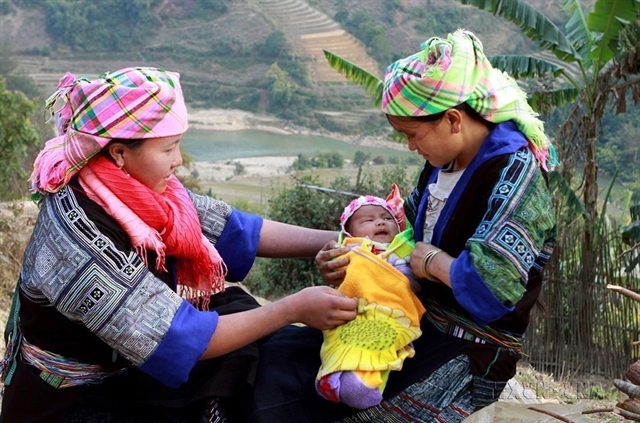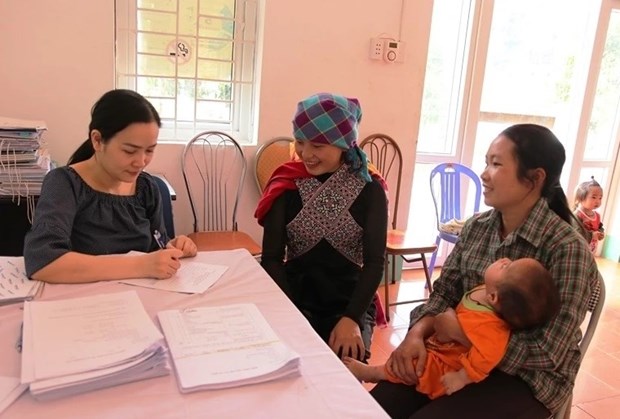 Society
Society

 |
| A village-based midwife gives instruction on breast-feeding to a minority ethnic mother. — VNA/VNS Photo Dương Ngọc |
LÀO CAI — In minority ethnic and mountainous areas of Lào Cai Province, access to reproductive health services is limited, and the province has determined that improving population quality is a particularly important factor in local socio-economic development.
Be safe mothers
Lào Cai health sector has been implementing many "Safe Motherhood" programmes and projects raising awareness and changing people’s behaviour on maternal and newborn health care.
For her second time giving birth, Giàng Thị Xua, a Mông ethnic woman in Lèng Pàng Village, Nậm Mòn Commune, Bắc Hà District, initially intended to give birth at home like the previous time.
Then a local health station staff member came to her home for regular prenatal checkups, distributed free multi-micronutrient tablets, and enthusiastically advised her of the benefits of going to a medical facility to give birth.
Xua changed her mind.
When there were signs of labour, her family took her to the Bắc Hà District General Hospital to give birth.
She said that she was told by the medical staff about the risk of tetanus and complications during labour if giving birth at home, so her family chose to give birth at the hospital.
"The doctors give me instruction on breast-feeding and baby monitoring in meticulous detail, so I feel secure," Xua said.
Doctor Vàng Seo Sào from the Bắc Hà District General Hospital said that most ethnic people lacked knowledge about taking care of themselves and their newborns.
When they come to the hospital, doctors actively guide them on how to care for the health of both mother and baby to prevent and avoid obstetric complications and reduce the rate of neonatal mortality.
According to the Lào Cai Centre for Disease Control, in the first nine months this year, the number of pregnant women receiving prenatal check-ups at least three times reached 85.5 per cent.
The number of mothers and newborns receiving postpartum care reached 79.5 per cent.
In the period 2022-23, the "Safe Motherhood" project in Lào Cai focused on improving the capacity of village midwives and health workers in charge of reproductive health programmes in 18 communes in five localities, including Mường Khương, Văn Bàn, Bát Xát, Si Ma Cai districts and Sa Pa Town.
Tả Tà Lé Village in Trung Lèng Hồ Commune is one of the most difficult villages in Bát Xát District.
Local people have limited awareness. Besides, it has poor economic conditions and women give birth many times.
Pregnant women in the last period of their pregnancy still go to work in the fields, so many babies are born in the fields without anyone helping.
Because she had just given birth to her first child, Thào Thị Dù in Tả Tà Lé Village had no experience.
Luckily, midwife Lầu Thị Xua came to help and enthusiastically advised and showed her how to take care of the baby.
Dù said that throughout her pregnancy until 42 days after giving birth, she and other pregnant women in the village were examined by midwife Xua and instructed on how to properly care for the foetus and the newborns.
Every month, Xua actively organises health education in the community, monitors pregnant women in the village, and encourages them to go to the commune health station to register for pregnancy management, prenatal check-ups and giving birth.
She also advises women to be vaccinated against tetanus and to fully vaccinate children of all ages.
Xua is one of 60 village midwives in the Lào Cai midwifery network in five districts and towns.
They are performing well as home counsellors, providing health care services for mothers and children, and giving examinations to pregnant women and newborns.
This is considered a very effective solution in the current period to remove geographical, cultural and financial barriers so that more and more ethnic women can access safe motherhood services.
Improving children's nutrition
 |
| Mông ethic woman listening to nutrition consultancy in Trung Lèng Hồ Commune, Bát Xát District, Lào Cai Province. — VNA/VNS Photo |
In addition to strengthening maternal health care, reducing the rate of malnutrition in children under five years old is one of the priority tasks of Lào Cai Province.
However, it remains a difficult task for this remote mountainous province.
In recent years, Lào Cai has made many efforts in improving children's nutritional status and has made significant achievements.
The rate of underweight malnutrition decreased from more than 19.6 per cent in 2015 to 15 per cent in 2021.
However, it is still among the highest in the country.
Lục Hậu Giang, deputy director of the Lào Cai Department of Health, said that in the coming time, the province would promote nutrition programmes focussing on improving micronutrient deficiency in children and pregnant women, building nutritional models to raise people’s awareness on the issue.
One of the projects that Lào Cai will expand is improving community-based child care and nurturing practices.
This model was created to manage and treat acutely malnourished children based in the community.
After seven years, the province has built nearly 50 models with positive working results.
Recently, the National Institute of Nutrition (NIN) surveyed Sàng Ma Sáo, Trung Lèng Hồ and Cốc Mỳ communes in Bát Xát District to deploy a pilot model of nutritional care in the first 1,000 days for local ethnic children.
After assessing the current situation, the NIN proposed support for households in agricultural production to improve maternal and child nutrition, giving nutritional training to health workers and village women, and establishing nutrition clubs in villages.
The work is under a project on people's health care, improving the physical condition and stature of ethnic groups, preventing and combating child malnutrition following the National Target Programme for socio-economic development in minority ethnic groups and mountainous areas for the period 2021-30. — VNS




